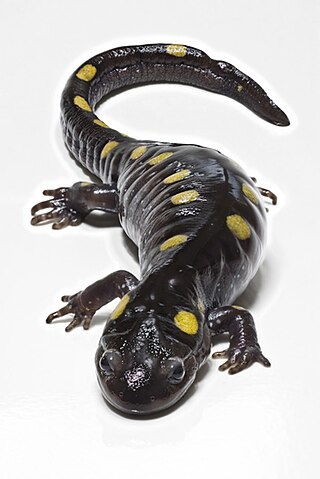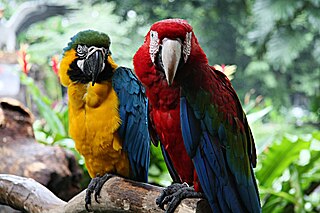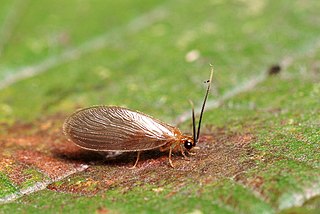
Salamanders are a group of amphibians typically characterized by their lizard-like appearance, with slender bodies, blunt snouts, short limbs projecting at right angles to the body, and the presence of a tail in both larvae and adults. All ten extant salamander families are grouped together under the order Urodela from the group Caudata. Salamander diversity is highest in eastern North America, especially in the Appalachian Mountains; most species are found in the Holarctic realm, with some species present in the Neotropical realm.

Leiocephalidae, also known as the curlytail lizards or curly-tailed lizards, is a family of iguanian lizards restricted to the West Indies. One of the defining features of these lizards is that their tail often curls over. They were previously regarded as members of the subfamily Leiocephalinae within the family Tropiduridae. There are presently 30 known species, all in the genus Leiocephalus.

Plethodontidae, or lungless salamanders, are a family of salamanders. Most species are native to the Western Hemisphere, from British Columbia to Brazil, although a few species are found in Sardinia, mainland Europe south of the Alps, and South Korea. In terms of number of species, they are by far the largest group of salamanders.

Dominican amber is amber from the Dominican Republic derived from resin of the extinct tree Hymenaea protera.

Ara is a Neotropical genus of macaws with eight extant species and at least two extinct species. The genus name was coined by French naturalist Bernard Germain de Lacépède in 1799. It gives its name to and is part of the Arini, or tribe of Neotropical parrots. The genus name Ara is derived from the Tupi word ará, an onomatopoeia of the sound a macaw makes.

The Rodrigues parrot or Leguat's parrot is an extinct species of parrot that was endemic to the Mascarene island of Rodrigues. The species is known from subfossil bones and from mentions in contemporary accounts. It is unclear to which other species it is most closely related, but it is classified as a member of the tribe Psittaculini, along with other Mascarene parrots. The Rodrigues parrot bore similarities to the broad-billed parrot of Mauritius, and may have been related. Two additional species have been assigned to its genus, based on descriptions of parrots from the other Mascarene islands, but their identities and validity have been debated.

The Hispaniolan solenodon, also known as the agouta, is a small, furry, shrew-like mammal endemic to the Caribbean island of Hispaniola. Like other solenodons, it is a venomous, insect-eating animal that lives in burrows and is active at night. It is an elusive animal and was only first described in 1833; its numbers are stable in protected forests but it remains the focus of conservation efforts.

The golden swallow is a swallow endemic to the Caribbean island of Hispaniola and was once native to Jamaica, but is now extirpated there. It is restricted to isolated montane forests that primarily consist of the Hispaniolan pine. This species is considered to be a vulnerable species by the International Union for Conservation of Nature (IUCN). The exact cause of its extirpation from Jamaica is unknown, but likely factors include predation by introduced mammals and habitat loss, although the habitat loss theory is not supported by much evidence. The last sighting of the nominate subspecies was in Hardwar Gap, with three birds being seen on 8 June 1989.

The Ezo salamander, also known as the Hokkaido salamander, Noboribetsu salamander, or Ezo Sanshouo in Japanese is a species of salamander in the family Hynobiidae. Prior to 1923 the species was also classified by the binomial scientific name Satobius retardatus. H. retardatus is endemic to Japan's northernmost prefecture, the island of Hokkaido. The species is a pond-type salamander, and its natural habitats are temperate forests, temperate shrubland, swamps, freshwater marshes, intermittent freshwater marshes, freshwater springs, irrigated land, canals, and ditches.
The amber salamander, amber-colored salamander, tortoiseshell salamander, or Stejneger's oriental salamander is a species of salamander in the family Hynobiidae, endemic to Japan. Its natural habitats are temperate forests and rivers. It is threatened by habitat loss.

Sisyridae, commonly known as spongeflies or spongillaflies, are a family of winged insects in the order Neuroptera. There are approximately 60 living species described, and several extinct species identified from the fossil record.

Triatoma dominicana is an extinct species of assassin bug in the subfamily Triatominae, the kissing bugs known from early Miocene Burdigalian stage Dominican amber deposits on the island of Hispaniola.
Neocorynura electra is an extinct species of sweat bee in the Halictidae genus Neocorynura.

The Cuban crocodile is a small-medium species of crocodile endemic to Cuba. Typical length is 2.1–2.3 m (6.9–7.5 ft) and typical weight 70–80 kg (150–180 lb). Large males can reach as much as 3.5 m (11 ft) in length and weigh more than 215 kg (474 lb). Despite its smaller size, it is a highly aggressive animal, and potentially dangerous to humans.

Lutzomyia adiketis is an extinct species of sandfly in the moth fly subfamily Phlebotominae. L. adiketis is a vector of the extinct Paleoleishmania neotropicum and both species are solely known from early Miocene Burdigalian stage Dominican amber deposits on the island of Hispaniola.

Aphaenogaster amphioceanica is an extinct species of ant in the subfamily Myrmicinae known from a single possibly Miocene fossil found in amber on Hispaniola. At the time of description A. amphioceanica was one of two Aphaenogaster species known from the Caribbean islands.

Odontomachus pseudobauri is an extinct species of ant in the subfamily Ponerinae known from one possibly Miocene fossil found on Hispaniola. O. pseudobauri is one of two species in the ant genus Odontomachus to have been described from fossils found in Dominican amber and is one of a number of Odontomachus species found in the Greater Antilles.

Mesembrinella caenozoica is an extinct species of blow fly in the family Mesembrinellidae. The species is solely known from the Middle Miocene Dominican amber deposits on the island of Hispaniola.

Enischnomyia is an extinct genus of bat fly in the family Streblidae. At the time of its description the new genus comprised a single species, Enischnomyia stegosoma, known from a single Miocene fossil found on Hispaniola. E. stegosoma was the first fossil streblid bat fly described from a fossil, and the only member of the subfamily Nycterophiliinae described from Hispaniola. The species is host for the plasmodiid Vetufebrus ovatus preserved in its salivary glands and midgut.


















